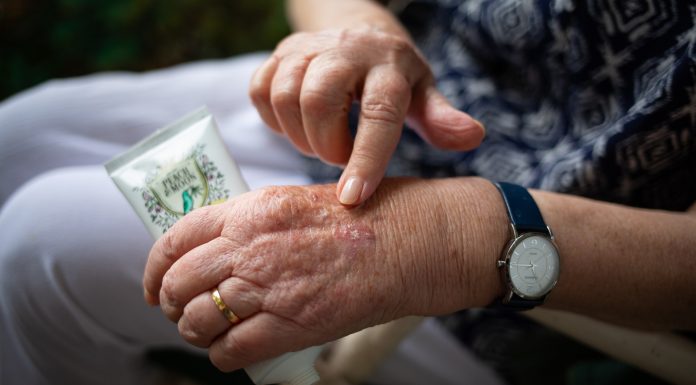“Big buns”
My blog this time was prompted by a flood of posts coming into my inbox around January of this year about how to get full, rounded buttocks. The subject is a popular one and flogged on a regular basis, so it isn’t too late for me to have my say.
In fact, articles about big buns have never disappeared in the almost forty years since they first came under my radar. While I’m all for strengthening the buttocks, my complaint for these many years has been the sway-backed, “butt-in-your-face” photos accompanying the articles that have no relevance to the actual purpose of having strong butt muscles. Worse still, they give a misguided message to women besides doing damage to their bodies.
So this article is written partly as a rant against sexist advertising but also simply as information for those individuals who are interested in the buttocks from a practical, everyday usage point of view and how to strengthen them for that purpose.
“For men and women”
The photo that caught my attention in January, shown here, accompanied an article entitled, ”For Men and Women Who Are Looking To Build and Grow Their Butt.” I don’t know how the combination of the photo and title strikes you, but my immediate thought was, “If big butts are important to men as well as to women, why isn’t the man standing with his knees bent, like the woman, to more clearly show off his “rounded buns?” The discrepancy between the article being for both men and women yet with only the female prominently displaying her butt was too obvious to let pass without comment.
Photos of women with over-arched backs and eye-catching bottoms have been used to attract attention to every which kind of product, regardless if its actual use, since the dawn of advertising. But have you ever seen a photo of a man standing like that? Makes you laugh, doesn’t it? The only photos of men that have any semblance to this kind of posture are for the purpose of explaining a forward tilted pelvis and the wrong way to stand. What makes it right, then, for a woman to tilt her pelvis, and in an exaggerated way at that, so she’s standing even more wrong?
Double standard
Talk about a double standard! It’s not only okay; women are encouraged to stand so your eyes are drawn to their buttocks. But do that as a man and you’d better be talking about how a tilted pelvis is the cause of lower back pain and a host of other non-healthy problems.
The article goes on to state that a flat bottom is a sign of weakness, yet it shows the man’s backside as flat. Is it because, as suggested above, a picture of a man showing off his butt would be met with derision, or maybe even cause an angered revolt against the audacity of displaying such an undignified photo of male posture?
In this day and age when the degrading of women in its many forms is unacceptable, exploiting the female body for commercial gain by promoting distorted, unhealthy posture is morally wrong on two counts: it’s demeaning to women and a disservice to both sexes by increasing the already epidemic cases of lower back pain and other negative consequences that an overly arched back inflicts on health and wellbeing.
Proper use of buttock muscles
Political overtones aside, what’s missing in the butt-focused articles is the unmentioned, if not unrecognized, role that the buttocks play in ordinary, everyday activities like walking and running. The buttocks are, in fact, along with the feet—the use of which deserves its own blog—the source of the impetus that moves the body forward. Or they should be.
You just have to look at the way four-legged animals use their haunches—the combined buttocks and thighs—when walking. They push themselves forward by using the muscles of their hindquarters. They have no choice; they have no other way to transfer their weight onto their front legs. But fortunately for them, the very act of walking is what also strengthens their rump.
To our disadvantage, our upright posture provides no such automatic strengthening; Because of this we have to a great extent lost the use of our buttock muscles. We move our bodies forward by extending one leg in front and letting our weight fall onto the foot, one step at a time. I call walking this way “catching up to your feet.” It’s what we do when we amble and it requires next to no energy or muscle strength.
Engaging the correct muscles
In our modern society, too much sitting has caused weak and flabby buttock muscles that contribute nothing to the purpose for which they’re intended, that is, walking. To paraphrase my writing from many years ago, when we don’t walk by actively engaging our buttock muscles, they’re just excess weight that we carry around like so much baggage. At best, they’re padding to cushion our bony framework when sitting or, at worst, pounds of inert flesh and adipose tissue to weigh us down and strain our hearts.
When we put the focus of strengthening the buttocks on their true purpose, it makes the action of walking a whole different ball game. Strong buttocks propel you forward with vibrant energy and help maintain your pace for longer. However, it’s not the main part of the buttocks—the rounded buns—that need strengthening for walking; rather, it’s the lower part of the buttocks where they connect with the hamstrings. Instead of being shaped as part of the buttocks, the muscles here are often slack from non-use and appear to hang separately below the buttocks.
These are the muscles that, when used, energize your walk and make your body feel like it’s being “carried” by your legs in a smooth, gliding feeling. Strengthening these muscles makes your buttocks firm, toned and an active part of your body, rather than being of little more use than the padded buttock shapers sold to the less fortunately endowed in this particular area.
How to strengthen the “walking” buttock muscles
The simplest and, for some, the most difficult way to strengthen the lower buttock muscles is through isolated contraction, the same way you make a strong fist with your hand. That said, when the lower muscles have not been used in a conscious way, they could be obscure to connect with, let alone to strengthen.
However, once you can “make a fist” with your lower buttock muscles and consciously contract them at will, you can use any moments of standing, such as when you’re waiting in line, to practise strengthening them. Strengthening these lower buttock muscles also helps bring the bottom of the pelvis forward and lengthen the lower back, relieving pain.
To make your buttocks the powerhouse they’re meant to be for everyday use, here is a 3-part buttock strengthening exercise that will put zap in your stride. Though simple, it’s highly strengthening and a challenge for building muscular stamina. In fact, you’ll be amazed at how quickly your butt muscles tire. That’s common when you haven’t worked these muscles this way before, but just as repetition in working any muscle gradually strengthens it, the same will happen with this exercise, too, when you make a practice of doing it on a regular basis.
This exercise is from my 1980s and current Somatic Stretch program. For this and other exercises that help make you “body aware”, go to: https://www.somaticstretch.com/store.























